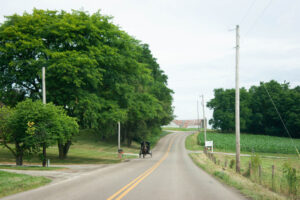If you’ve ever stepped out into the spring woods in search of mushrooms, you probably understand how a  person could get serious about hunting — mushroom hunting, that is. As winter gives way to bustling green growth, the forest floor comes alive. Some of its most dynamic, beautiful and delicious inhabitants are fungi. Tracking down wild mushrooms as they pop up through leaves in a sun-dappled woodland is so much more of a culinary adventure than plodding through the grocery store and picking up a plastic-wrapped carton of portabellas. The expedition lends as much flavor to the mushrooms as the lush soil that grew them.
person could get serious about hunting — mushroom hunting, that is. As winter gives way to bustling green growth, the forest floor comes alive. Some of its most dynamic, beautiful and delicious inhabitants are fungi. Tracking down wild mushrooms as they pop up through leaves in a sun-dappled woodland is so much more of a culinary adventure than plodding through the grocery store and picking up a plastic-wrapped carton of portabellas. The expedition lends as much flavor to the mushrooms as the lush soil that grew them.
Wild mushrooms are packed with antioxidants and vitamins, boasting the best non-animal source of Vitamin D. They also contain chitin, a protein that helps the body break down cholesterol, and beta-glutan, a carbohydrate that has been associated with heart health. So, they’re nutritious, thrilling to find and full of gourmet flavor. But before you set out on a mushroom hunt, it’s important to beef up on a few basic facts.
Wild Mushroom Safety
A saying among mushroom enthusiasts advises, “There are old mushroom hunters and bold mushroom hunters, but there are no old, bold mushroom hunters.” The idea is that it’s better to be safe than sick from an unknown mushroom, so stick to those that are commonly eaten and easy to identify. This time of year, it’s all about the 
Start your mushroom hunt online by visiting EdibleWildMushrooms.com. This website offers info-packed links to help identify morels (and other mushrooms that you may get inspired to hunt).
Once you’re comfortable identifying your quarry, keep these simple safety precautions in mind:
– Only harvest mushrooms that appear fresh and undamaged.
– Cook mushrooms before eating.
– Start with a nibble if you’re new to wild fungi to make sure you have no adverse reactions.
When to Start Searching
There is no hard and fast date when mushroom season begins. Depending upon the weather, morels may spring up as early as March or as late as June. A good rule of thumb is to start searching as soon as temperatures reach 65 degrees in the daytime and stay above 40 degrees at night. Ideal mushroom days are warm, sunny and moist from a recent rain.
Where to Look
Morels have an undeniable mystique — you never can tell just where they might appear. Forests, fields, even backyards are fair game. Morels grow from the ground (not on tree trunks), so they can often be overlooked in leaf litter or dense brush. If you spot one, however, there’s a good chance you’ll find more nearby. Creek bottoms and areas where wildfires burned the previous year are prime places to find bumper crops. Certain trees also seem to attract morels, including ash, sycamore, cottonwoods and dead or dying elms. As much fun as it can be to spy a morel growing along a roadside, railway or city park path, these places are often treated with pesticides that you probably don’t want to eat. In other words, the wilder, the better!
What to Bring
Mushroom hunting doesn’t require fancy equipment. Many an old-time forager has simply removed his hat to fill it with a serendipitous bounty of morels, but planning ahead can make your outing more comfortable. Here’s a short list of items that will help you gear up:
– cloth bags or baskets to carry mushrooms (plastic can encourage decay)
– pocket knife to trim stems neatly and remove soil
– garden gloves
– drinking water and snacks
– cooler with ice to keep mushrooms cool on the ride home
– guidebook
Mushrooms in the Kitchen
When you get back home with your fresh morel mushrooms, slice them in half, rinse gently with cold water and pat dry with a towel. At this point, you can cook or freeze them. To freeze, arrange mushroom halves in a single layer on a cookie sheet, freeze, then place in freezer containers to keep for up to one year. Chances are, though, you’ll be eager to sample some of your harvest.
A simple saute of morels in butter or olive oil is exquisite, but if you managed to bring home bushels, it’s fun to experiment with different dishes. You can fry, stuff or add them to any recipe that calls for mushrooms. There are some lovely looking recipes at www.marxfoods.com/-/Morel-Mushroom-Recipes.
Copyright 2011, MaryJane Butters.
Distributed by United Feature Syndicate, Inc.
































[…] http://empty.lehmans.com/2011/03/17/wild-mushrooms/#more-6531 […]
OOOOOOOh BINGO! I just got back in the house from my woods and got to thinking MORELS… SOON!
ramps and morels – is it spring yet
Mmm…morels….
Pan fried with beef tips and fresh onion then served over noodles.
Chopped, and thrown into scrambled eggs with onion, ham, and cheese is also goooood as a breakfast delight.
Mushrrom hunting is a blast and not nearly as much work as chasing away the mushroom poachers. What’s with normally nice church ladies who don’t hesitate to jump a fence and poach morels?